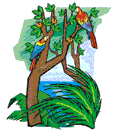Life Cycles of Animals
A lesson and worksheet on the life cycles of animals.
Objectives:
• Students will be able to define the term life cycle and will understand that all animals have life cycles.
• Students will be able to define metamorphosis.
• Students will be able to distinguish between complete metamorphosis and incomplete metamorphosis.
• Students will be able to state specific ways that certain animals change during the course of their life cycles.
Suggested Grades:
3rd Grade - 4th Grade - 5th Grade
Print the reading comprehension worksheet passage and questions (see below).
Students should read the passage silently, then answer the questions. Teachers may also use the text as part of a classroom lesson plan.
Lesson Excerpt:
The term life cycle refers to the stages and changes that occur throughout an animal's life. The development of animals from their baby form into their adult form is called metamorphosis. Some baby animals look nothing like the adult animals they will become. For example, baby frogs, known as tadpoles, emerge from their eggs looking very different from adult frogs. Very young tadpoles have gills and no limbs. They look almost like fish. They grow into larger tadpoles with limbs before finally become adult frogs.
Insects go through two different types of metamorphosis - complete and incomplete. In complete metamorphosis, insect eggs hatch and become wormlike larva. They then go through a stage where they are called pupa. During this stage their bodies change a great deal. Some of them spin cocoons where they can stay sheltered from the environment as they grow into adults.
Continued...

Lesson Printables:
Print this printable worksheet for this lesson:


